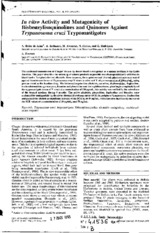Mostrar el registro sencillo del ítem
In vitro activity and mutagenicity of bisbenzylisoquinolines and quinones against Trypanosoma cruzi Tripomastigotes
| dc.contributor.author | Rojas de Arias, A | |
| dc.contributor.author | Inchausti, A | |
| dc.contributor.author | Ascurrat, M | |
| dc.contributor.author | Fleitas, N | |
| dc.contributor.author | Rodríguez, E | |
| dc.contributor.author | Fournet, A | |
| dc.date.accessioned | 2018-05-03T16:03:55Z | |
| dc.date.available | 2018-05-03T16:03:55Z | |
| dc.date.issued | 1994 | |
| dc.identifier.uri | http://repositorio.umsa.bo/xmlui/handle/123456789/15665 | |
| dc.description.abstract | Abstract. The accidental transmission of Chagas' disease by donor blood is recognized as a serious problem in the Latin America. This paper describes the screening of natural products as possible new chemoprophylactic additives in blood banks. Ten plant-derived alkaloids, three terpenes, three quinones and 14 crude plant extracts were tested against bloodstream forms of Trypanosoma cruzi Y strain in vitro at 4 ⁰C at a concentration of 250 µg/mL, using gentian violet as the baseline drug. The bisbenzylisoquinoline alkaloids, cocsuline, daphnandrine, daphnoline, isochondodendrine, gyrocarpine, limacine and pheanthine and the naphthoquinone, plumbagin completely lysed the trypomastigote forms of T. cruzi at a concentration of 250 µg/mL, this activity was verified by the subculture of the treated medium during 4 months. The active alkaloids, pheanthine, daphnoline and limacine were evaluated for mutagenicity by the sister chromatid exchange assay (SCE) in peripheral lymphocytes. Daphnoline and pheanthine elicited no significant increase of the SCE up to 50 µg/mL, while limacine significantly increased the SCE values at a concentration of 25 µg/mL, and 50 µg/mL. | es_ES |
| dc.language.iso | en | es_ES |
| dc.publisher | PHYTOTHERAPY RESEARCH | es_ES |
| dc.subject | TRYPANOSOMA CRUZI | es_ES |
| dc.subject | TRYPOMASTIGOTE | es_ES |
| dc.subject | ALCALOIDES BISBENZYLISOQUINOLINE | es_ES |
| dc.subject | MUTAGENICIDAD | es_ES |
| dc.subject | NAFTOQUINONAS | es_ES |
| dc.title | In vitro activity and mutagenicity of bisbenzylisoquinolines and quinones against Trypanosoma cruzi Tripomastigotes | es_ES |
| dc.type | Article | es_ES |

